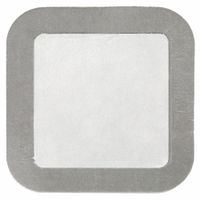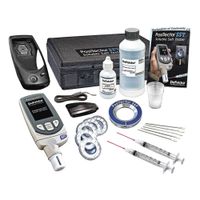Call +(254) 703 030 000 / 751 483 999 / 721 704 777
- Home
- Test Instruments
- Nonelectrical Properties Testing
- Soluble Salt Testers Accessories
.....Read More
Frequently Asked Questions
What is a soluble salt tester and how does it work?
A soluble salt tester is a device used to measure the concentration of soluble salts on surfaces, particularly in industrial settings where surface preparation is critical, such as before painting or coating. Soluble salts, like chlorides, sulfates, and nitrates, can cause adhesion problems and lead to premature coating failures, so their detection and measurement are essential.
The tester typically works by extracting soluble salts from a surface using a specific method, such as the Bresle method, which involves applying a patch to the surface and injecting a known volume of distilled water. The water dissolves the salts present on the surface. After a set period, the solution is extracted and analyzed.
The analysis is often conducted using a conductivity meter, which measures the electrical conductivity of the solution. Since dissolved salts increase the conductivity of water, the meter can provide a reading that correlates to the concentration of salts. The result is usually expressed in micrograms per square centimeter (µg/cm²).
Some advanced testers may use ion-specific electrodes or other methods to identify and quantify specific ions, providing more detailed information about the types of salts present. The data obtained helps in assessing the cleanliness of the surface and determining if further cleaning is necessary before proceeding with coating or painting.
In summary, a soluble salt tester is a crucial tool in quality control for surface preparation, ensuring that surfaces are adequately cleaned to prevent coating failures and extend the lifespan of the applied coatings.
How do I choose the right soluble salt tester for my needs?
To choose the right soluble salt tester, consider the following factors:
1. **Application Needs**: Determine the specific type of soluble salts you need to measure, such as chlorides, sulfates, or nitrates. Different testers may be optimized for specific ions.
2. **Measurement Range and Sensitivity**: Ensure the tester can measure the concentration range you expect in your samples. High sensitivity is crucial for detecting low levels of contamination.
3. **Accuracy and Precision**: Look for testers with high accuracy and precision to ensure reliable results. Check for calibration options to maintain accuracy over time.
4. **Ease of Use**: Consider the user interface and ease of operation. A tester with a simple, intuitive design can save time and reduce user error.
5. **Portability**: If field testing is required, choose a portable, lightweight tester that is easy to transport and use on-site.
6. **Durability and Build Quality**: Select a tester with robust construction, especially if it will be used in harsh environments. Water and dust resistance can be important features.
7. **Data Logging and Connectivity**: For extensive testing, a tester with data logging capabilities and connectivity options (e.g., USB, Bluetooth) can facilitate data management and analysis.
8. **Cost and Budget**: Balance your budget with the features you need. While more expensive models may offer advanced features, ensure they align with your requirements.
9. **Brand Reputation and Support**: Choose a reputable brand known for quality and reliability. Consider the availability of customer support, warranty, and service options.
10. **Compliance and Standards**: Ensure the tester complies with relevant industry standards and regulations for your specific application.
By evaluating these factors, you can select a soluble salt tester that meets your specific needs and provides accurate, reliable measurements.
What are the common types of soluble salt testers available?
Common types of soluble salt testers include:
1. **Conductivity Meters**: These devices measure the electrical conductivity of a solution, which correlates with the concentration of soluble salts. They are widely used due to their simplicity and quick results.
2. **Chloride Ion Test Kits**: These kits specifically measure chloride ions, a common component of soluble salts. They often use titration or colorimetric methods to determine chloride concentration.
3. **Bresle Patches**: This method involves using adhesive patches to extract soluble salts from a surface. The extracted solution is then analyzed, often with a conductivity meter, to determine salt levels.
4. **Salt Contamination Meters**: These are portable devices designed to measure the total salt contamination on surfaces. They often combine multiple testing methods for comprehensive analysis.
5. **Ion-Selective Electrodes (ISEs)**: These electrodes are used to measure specific ions, such as chloride or sulfate, in a solution. They provide precise measurements and are useful for targeted analysis.
6. **Colorimetric Test Strips**: These strips change color based on the concentration of specific ions in a solution. They are easy to use and provide quick, albeit less precise, results.
7. **Gravimetric Analysis Kits**: These kits involve evaporating a solution to leave behind soluble salts, which are then weighed. This method is accurate but more time-consuming.
8. **Spectrophotometers**: These devices measure the absorbance of light by a solution, which can be correlated with salt concentration. They are used for detailed analysis in laboratory settings.
9. **Portable Multi-Parameter Meters**: These devices can measure various parameters, including pH, conductivity, and specific ions, providing a comprehensive analysis of soluble salts.
Each type of tester has its own advantages and limitations, and the choice depends on factors like the required accuracy, the specific ions of interest, and the testing environment.
How do I properly maintain and calibrate a soluble salt tester?
To properly maintain and calibrate a soluble salt tester, follow these steps:
1. **Regular Cleaning**: After each use, rinse the tester with distilled water to remove any residual salts or contaminants. Dry it with a lint-free cloth to prevent any buildup that could affect readings.
2. **Storage**: Store the tester in a clean, dry place. Ensure the storage environment is free from extreme temperatures and humidity, which can damage the device.
3. **Calibration Frequency**: Calibrate the tester regularly, ideally before each use, to ensure accuracy. The frequency may depend on the manufacturer's recommendations and the frequency of use.
4. **Calibration Solution**: Use a standard calibration solution with a known concentration of salts. This solution should match the range of the tester for accurate calibration.
5. **Calibration Process**:
- Turn on the tester and immerse the probe in the calibration solution.
- Allow the reading to stabilize.
- Adjust the calibration knob or use the digital interface to set the tester to the known value of the calibration solution.
- Rinse the probe with distilled water after calibration.
6. **Check for Damage**: Regularly inspect the probe and connections for any signs of wear or damage. Replace any damaged parts immediately to maintain accuracy.
7. **Battery Maintenance**: Ensure the batteries are in good condition. Replace them as needed to prevent power-related inaccuracies.
8. **Documentation**: Keep a log of calibration dates and any maintenance performed. This helps track the tester's performance and identify any recurring issues.
9. **Follow Manufacturer's Instructions**: Always refer to the user manual for specific maintenance and calibration instructions tailored to your model.
By adhering to these practices, you can ensure your soluble salt tester remains accurate and reliable.
What accessories are essential for a soluble salt tester?
Essential accessories for a soluble salt tester include:
1. **Conductivity Meter**: Measures the conductivity of the solution, which is directly related to the concentration of soluble salts.
2. **Sample Extraction Pads**: Used to collect soluble salts from the surface being tested. These pads are often pre-wetted with a specific solution to ensure accurate extraction.
3. **Calibration Solutions**: Necessary for calibrating the conductivity meter to ensure accurate readings. These solutions have known conductivity values.
4. **Syringes or Pipettes**: Used for precise application of extraction solutions onto the sample extraction pads.
5. **Deionized Water**: Used for rinsing and cleaning equipment to prevent contamination and ensure accurate results.
6. **Carrying Case**: Protects the tester and its accessories during transport and storage, ensuring they remain in good condition.
7. **Instruction Manual**: Provides guidance on the proper use and maintenance of the tester and its accessories.
8. **Data Recording Sheets or Software**: For documenting test results and ensuring traceability and consistency in testing.
9. **Replacement Electrodes**: Spare electrodes for the conductivity meter, as they can wear out over time and affect accuracy.
10. **Cleaning Solutions**: Specific solutions for cleaning the electrodes and other parts of the tester to maintain performance.
11. **Protective Gloves**: To ensure safety and prevent contamination of samples during testing.
12. **Portable Power Supply or Batteries**: Ensures the tester can be used in various locations without access to a power outlet.
These accessories are crucial for the effective operation and maintenance of a soluble salt tester, ensuring accurate and reliable measurements.
How accurate are soluble salt testers in measuring salt levels?
Soluble salt testers are generally considered accurate for measuring salt levels, particularly in applications like agriculture, food processing, and water quality testing. These devices typically use electrical conductivity (EC) to estimate the concentration of dissolved salts in a solution. The accuracy of these testers can vary based on several factors:
1. **Calibration**: Regular calibration against standard solutions is crucial for maintaining accuracy. Without proper calibration, readings can drift over time, leading to inaccurate measurements.
2. **Range and Sensitivity**: Different testers have varying ranges and sensitivity levels. High-quality testers can detect a broader range of salt concentrations with greater precision, while cheaper models may have limited sensitivity.
3. **Interference**: The presence of other dissolved ions or substances can interfere with the readings. For instance, high levels of organic matter or other minerals can affect the conductivity measurement, leading to potential inaccuracies.
4. **Temperature Compensation**: Temperature can influence conductivity readings. Many modern testers include automatic temperature compensation (ATC) to adjust readings based on the solution's temperature, enhancing accuracy.
5. **Maintenance and Handling**: Proper maintenance, such as cleaning the electrodes and storing the device correctly, is essential for accurate readings. Mishandling or neglect can lead to sensor degradation and erroneous results.
6. **Sample Homogeneity**: The sample being tested should be well-mixed and representative of the entire solution. Inhomogeneous samples can lead to inconsistent readings.
Overall, while soluble salt testers are generally reliable, their accuracy depends on proper calibration, maintenance, and consideration of environmental factors. For critical applications, it may be advisable to use them in conjunction with other methods or to verify results with laboratory analysis.
Can soluble salt testers be used on all types of surfaces?
Soluble salt testers are designed to measure the concentration of soluble salts on surfaces, which is crucial for ensuring proper adhesion of coatings and preventing corrosion. However, their applicability can vary depending on the type of surface.
1. **Metal Surfaces**: Soluble salt testers are commonly used on metal surfaces, especially in industries like marine, automotive, and construction, where metal surfaces are prevalent. They are effective in detecting contaminants that can lead to corrosion and coating failures.
2. **Concrete Surfaces**: These testers can also be used on concrete surfaces, although the porous nature of concrete can sometimes complicate the extraction and measurement of salts. Special techniques or adjustments may be necessary to obtain accurate readings.
3. **Painted or Coated Surfaces**: Testing on painted or coated surfaces is generally not recommended, as the coating can interfere with the extraction of salts from the substrate. It is best to test before applying any coatings.
4. **Non-Metallic Surfaces**: On non-metallic surfaces like plastics or composites, the use of soluble salt testers is less common and may not yield reliable results due to the different surface properties and lack of standard testing procedures.
5. **Surface Condition**: The condition of the surface, such as roughness or cleanliness, can also affect the accuracy of soluble salt testers. Proper surface preparation is essential for obtaining reliable measurements.
In summary, while soluble salt testers can be used on various surfaces, their effectiveness and accuracy depend on the surface type and condition. They are most reliable on clean, uncoated metal surfaces and may require special considerations or techniques for other types of surfaces.

